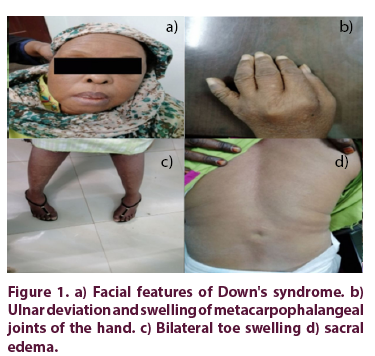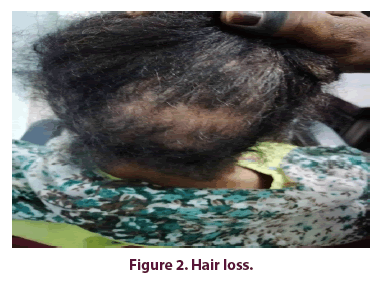Case Report - International Journal of Clinical Rheumatology (2020) Volume 15, Issue 2
Rheumatoid arthritis and gouty arthritis in an adult patient with Down's syndrome
- Corresponding Author:
- Shaima N Elgenaid
Faculty of Medicine University of Khartoum, Sudan
E-mail: Ashema2690@gmail.com
Ziryab2008@yahoo.com
Awadali818@yahoo.com
kareemo151@gmail.com
Abstract
Down’s syndrome is a chromosomal disorder caused by trisomy of chromosome 21. It presents with different phenotypes including autoimmune diseases and arthritis. The aim of this case report is to describe and document rheumatoid arthritis and gouty arthritis in patient with Down's syndrome. Here we are reporting a case of 44 year-old female with Down's syndrome who was diagnosed with epilepsy 10 months ago. She presented with a one-year history of swelling of knees, bilateral big toes and the metacrpopharyngal joints. In addition, on examination she had ulnar deviation of her hands, limited range of motion and severe tenderness of the noted joints, hair loss and scoliosis. Her serum uric acid, ESR and CRP levels were elevated and rheumatoid factor was strongly positive; however, ANA profile and anti CCP antibodies were negative. Therefore, she was diagnosed with rheumatoid arthritis and gouty arthritis. Currently she is on hydroxychoroquine, allopurinl, baclofen, methotrexate, folic acid and sodium valproate.
Keywords
arhtropathy • Down’s syndrome • gouty arthritis • rheumatoid arthritis
Abbreviations
ANA: Anti-Nuclear Antibodies; Anti CCP: Anti Cyclic Citrullinated Peptide; CRP: C Reactive Protein; ESR: Erythrocyte Sedimentation Rate; HCQ: Hydroxychloroquine; IL1: Interleukin 1; NSAID: Non- Steroidal Anti-Inflammatory Drugs; RBCs: Red Blood Cells; WBC: White Blood Cell count; TNF: Tumor Necrosis Factor
Introduction
Down's syndrome (trisomy 21) is the most common genetic cause of intellectual disability worldwide. While it is estimated to affect 1 in 732 infants in the United States [1], Down's syndrome prevalence in Sudan is unknown. The clinical manifestations of Down's syndrome include characteristic head, neck and extremities dimorphic features which occur in about 47% to 82% of cases, respiratory disorder (60%), behavioral and psychiatric disorder (17.6%), heart anomalies (42%), gastrointestinal tract anomalies (5%), hematologic disorder (1- 1.5%) and dementia [2]. Other uncommon features include arthropathy 0.8% and epilepsy which occurs in less than 10% of adults with Down's syndrome [2]. Data about arthritis in Down's syndrome are limited. In one study the prevalence of Down arthropathy was estimated to be 20/1000 and is usually affects multiple joints, however, there is a remarkable delay in diagnosis [3]. Rheumatoid factor can be negative and the patients may present with radiological findings of joints involvement [3]. Early recognition of Down arthropathy is needed for early intervention to prevent significant joints damage. This case report is the first one to document arthropathy in an adult patient with Down's syndrome in Sudan. We believe that it will focus doctors’ attention on the uncommon presentations of patients with Down's syndrome.
Case report
On November 2019, a 44-year-old lady was brought into Alryan private clinic, Khartoum, Sudan by her sister. The patient is a known case of Down’s syndrome with impaired speech and communication abilities. She had worsening bilateral knee pain especially while standing and sitting. Her condition started one year ago with similar pain which was symmetrical bilaterally, aggravated by movements and relieved by rest. It is not associated with swelling or numbness. Her sister also reported that the patient had had difficulty in hands movements including holding objects. She has morning stiffness, according to her sister noticed that it takes her more than half an hour in the morning to move her body. Moreover, it’s affecting her daily life activities as she is now unable to ambulate, bath, dress or feed herself. Four months ago, she developed an itchy papular skin rash which ends up scaly. She also suffers from hair loss and red itchy eyes. In systemic review, her sister reported that she had had slight weight loss despite a good appetite, one bowel motion per week and recurrent headaches and spasticity for the last year. In terms of her past medical history, she was diagnosed with epilepsy 10 months ago for which she is on sodium valproate, and since then she has been experiencing only one attack per month. There is no history of recurrent infections or other chronic illness such as diabetes and hypertension. She has a strong family history of rheumatoid arthritis but of no other autoimmune diseases. Her home medications include only sodium valproate 1000 mg/day.
General examination revealed prominent features of Down’s syndrome (Figure 1a), with speech difficulties, aided mobility on a wheelchair and normal vital parameters. Dry skin, brittle nails and hair loss at the back of the scalp were noted (Figure 2). Examination of her hands revealed ulnar deviation, slight tenderness and swelling at the metacarpophalangeal joints (Figure 1b), limited range of motion and functional disabilities of the hands. There was swelling at the knees with a limited range of motion but no tenderness. There was bilateral swelling of the big toes with severe tenderness (Figure 1c). Moreover, the examination of the back revealed sacral oedema (Figure 1d), scoliosis without vertebral tenderness. No other articular or extraarticular manifestations were noted.
Joint X ray and ultrasound were requested but could not be performed because the patient was not cooperative and could not stay still for the procedures. Investigations showed were given in Table 1 and now the patient is on HCQ 200 mg twice a day, Allopurinl 100 mg three times per day, Baclofen 5 mg twice a day, Methotrexate 15 mg once per week, Folic acid 5 mg once per week, Depomedrol (methylprednisolone) 80 mg once per day for three days.
| Investigation | Result |
|---|---|
| WBC | 6,000 cells/ mcL |
| RBC | 4.8 million cells/mcL |
| Hemoglobin | 12 mg/dl |
| Platelet | 250,000 cells/mcL |
| Hematocrit | 39% |
| ESR | >25 mm/hour (normal reference up to 20mm/hour) |
| CRP | Positive |
| Rheumatoid factor | Strong positive |
| Anti CCP antibodies | Negative |
| Serum uric acid | 8 mg/dl |
| Vitamin D-25-OH | 60 ng/ml (upper normal) |
| ANA profile | Negative |
Table 1. Investigations and results of patient.
Discussion
Down's syndrome (trisomy 21) is associated with autoimmune diseases and other conditions [2]. Arthritis also can occur in Down's syndrome and the incidence of arthritis in down syndrome arthropathy is greater than juvenile rheumatoid arthritis in general population; however, it is underdiagnosed [4,5]. In a study done by Juj et al. the estimated prevalence of Down's syndrome arthropathy was 8.7/1000 [5]. The patients usually present with polyarticular arthritis that affects five joints or more with predominance of hand joints, and about 42% of patients have radiological changes at the time of the diagnosis [3]. The treatment is complicated due to high risk of medications' side effect among patients [6].
Rheumatoid arthritis is an autoimmune disease that involves autoantibodies and immune complex formation. Activation of T lymphocyte and enhancement of cytokines production play an important role in the pathogenesis of the disease and it was considered as the base for using biological treatment such as TNF and IL1 inhibitors to reduce the inflammation [7].
In this case our patient presented with signs and symptoms indicative of rheumatoid arthritis at the age of 40. She had polyarticular joint involvement, which might be difficult to be detected early in patients with Down's syndrome as they might develop joint subluxation. The delay in the diagnosis of rheumatoid arthritis in Down's syndrome may take years [5], this patient had symptoms for about one year before presentation. As a result, she developed ulnar deviation, joints swelling, limitation of movement and functional impairment, which could have been prevented with early recognition and treatment. In most cases, Down's syndrome arthropathy is either missed to be diagnosed or been diagnosed after a long time which is usually associated with severe joint damage that can be irreversible [3]. Most of researches have studied Down's syndrome with juvenile rheumatoid arthritis in children [8,9]. In this case, the presentation was in adult which is less common. Our patient also presented with scoliosis, a musculoskeletal finding reported in about 4.8% of patients with Down's syndrome [4]. The diagnosis of rheumatoid arthritis was mainly based on the typical clinical manifestations and examination findings. Presence of rheumatoid factor supported this diagnosis as well.
However, she also developed signs and symptoms suggestive of gouty arthritis as she had bilateral tender swollen big toes and a serum uric acid level of 8 mg/dl. Gouty arthritis can present in Down syndrome with symptoms similar to rheumatoid arthritis and therefore not easily diagnosed [10]. This combination of arthritis is not common in Down's syndrome. Consequently, methylprednisolone, methotrexate, hydroxychloroquine and allopurinol were prescribed. Treatment of arthritis in Down's syndrome is not clear. Non- Steroidal Anti-Inflammatory Drugs (NSAID) have been used as a first line of treatment in many cases and methotrexate was used when there was no response and the patient developed sever manifestations, however, there is no clear guideline because of the side effects [5]. The patient was diagnosed with epilepsy 10 months ago. The risk of epilepsy in adult with Down's syndrome increases with age and the late onset epilepsy is associated more with evidence of dementia. The prevalence of epilepsy was estimated in one study to be 9.4% and it was considered as a cause of additional morbidity in patients with Down's syndrome [11].
Conclusion
In this case the patient was diagnosed with rheumatoid arthritis at the age of 44 after causing a significant damage and it was associated with gouty arthritis affecting both big toes, highlighting less common presentations in Down’s syndrome. Musculoskeletal assessment should be done on a regular basis for Down’s syndrome patients to detect and manage such conditions properly.
Disclosure of conflict of interest:
No conflict of interest.
References
- Sherman SL, Allen EG, Bean LH et al. Epidemiology of Down syndrome. Ment. Retard. Dev. Disabil. Res. Rev. 13(3), 221–227 (2007).
- Ostermaier KK. Down syndrome: Clinical features and diagnosis. UpToDate. (2019).
- Foley CM, Deely DA, MacDermott EJ et al. Arthropathy of Down syndrome: an under-diagnosed inflammatory joint disease that warrants a name change. RMD. Open. 5(1) (2019).
- Foley C, Killeen OG. Musculoskeletal anomalies in children with Down syndrome: an observational study. Arch. Dis. Child. 104(5), 482–487 (2019).
- Juj H, Emery H. The arthropathy of Down syndrome: an underdiagnosed and under-recognized condition. J. Pediatr. 154(2), 234–238 (2009).
- Jones JT, Talib N, Lovell D et al. Clinical features and treatment of Down syndrome arthropathy: experience from two us tertiary hospitals. Pediatr. Drugs. 21(1), 33–39 (2019).
- Firestein GS. Evolving concepts of rheumatoid arthritis. Nature. 423(6937), 356–361 (2003).
- Yancey CL, Zmijewski C, Athreya BH et al. Arthropathy of Down's syndrome. Arthritis. Rheumatism. 27(8), 929–934 (1984).
- Padmakumar B, Evans Jones L, Sills J. Is arthritis more common in children with Down syndrome? Rheumatology. 41(10), 1191–1193 (2002).
- Dacre J, Huskisson E. Arthritis in Down's syndrome. Ann. Rheum. Dis. 47(3), 254–255 (1988).
- McVicker R, Shanks O, McClelland R. Prevalence and associated features of epilepsy in adults with Down's syndrome. Br. J. Psychiatry. 164(4), 528–532 (1994).




